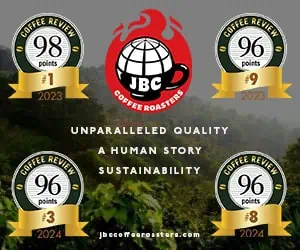In a book about coffee published in 1853 the following sentence appears: “For the New England trade a light roast is required, and for Western, a dark, or pretty full roast.”
Of course people in those days didn’t cross the country for weekend business trips, and if anyone used the term bicoastal it doubtless described someone who commuted between west and east Manhattan. Consequently we don’t know whether, in addition to roasting their coffees differently, the two coasts privately accused one another of selling out the great tradition of American coffee by either burning the coffee on one hand, or sending it out half raw on the other.
Things have heated up on the darker vs. lighter roast front lately, owing to the invasion of the heretofore complacently (and largely) lighter-roasting East Coast by the darker-roasting, latte-bibbing armies of the Dark Force, a.k.a. Starbucks. When the Dark Force managed to buy out one of the strongholds of the Light-Roast cause, Boston’s Coffee Connection (whose deposed general, owner George Howell, liked to call Starbucks “Charbucks”), the light-roast guys really got nervous.
Of course, all of this intercoastal warfare symbolism overlooks squabbles and tensions within the dark-roast camp, with Starbucks of Seattle cast as the conquering corporate Assyrians, whereas privately-held, Berkeley-based Peet’s Coffee & Tea is perceived as a more neighborly member of the dark-roast alliance, perversely persisting in its loyalty to the gods of the dark roast, but gentler in their business practices.
Although my little coffee-wars script exaggerates a bit, the tension between (and among the members of) the two camps is real. Darker roasting, with its lower acidity and bittersweet tang, has attracted a sizable chunk of the American coffee-drinking public, probably people who either never drank coffee before or who stopped drinking it because they came to associate it with the (genuinely) under-roasted, sour-tasting, thin-bodied, stale stuff served in gas stations and fast-food chains.
Naturally the light roasters rightfully object to such misunderstandings of their coffee, because they know that gas-station coffee no more represents the potential of lighter-roasting than packaged macaroni and cheese represents the culinary potential of pasta.
The main accusation of the lighter-roasters level at the darker-roasting camp is that dark roasting removes everything that makes individual coffees distinctive. By roasting the coffee so dark, the lighter roasters claim, its nuances, its subtleties and distinctions, are burned off and sent up the chimney. Sumatras taste like Costa Ricas, high-priced, rare coffees like cheap coffees. The coffee itself barely matters, since all we’re really tasting is the impact of the dark roast.
So the question animating the cupping this month is: When we dark-roast a fine coffee, do we really destroy it distinctiveness? Or can we enjoy the virtues of a dark roast, which I take to be the smooth, rich body and combination of pungency and sweetness, while also enjoying the acidy brightness and distinction of a fine single-origin coffee?
We asked six specialty coffee firms known for their darker style to submit their choice of single-origin coffees done in a dark roast. The firms include three West-Coast-based biggies – Peet’s, Starbucks, and Java City – as well as a smaller Berkeley roaster, Uncommon Grounds, one occasionally darker-roasting dissident from the East Coast, Armeno Coffee Roasters, and one from New Orleans, the Orleans Coffee Exchange. Their choices are heavy on Indonesia coffees, but include examples from Central America, Papua New Guinea and East Africa.
The answer to the question on the cupping table, judging from this sampling, is a (somewhat qualified) yes. Yes, you can have your dark roast and your unique character too.
In some cases the qualities of the green coffee carried through into the dark roast with startling clarity. The Orleans Coffee Exchange Yirgacheffe and the Starbucks Guatemala Antigua, for example, lost almost none of their individuality in the conversion, and even may have added some nuance. In other cases, the Orleans Coffee Exchange’s Costa Rica for example, the coffee’s qualities (clean, clear profile, powerful but understated acidity) translated into dark roast terms pleasantly, but not identifiably. In other words, I would have had trouble positively identifying the coffee as a Costa Rica in its dark-roast incarnation, but in retrospect I easily saw how the Costa Rica clarity and power worked itself out in parallel dark-roast terms.
Returning to the terms of my opening roast wars scenario, I was surprised, yet also reassured, that the two Starbucks entries fare so well. I share the widespread feeling that Starbucks is something of a bully. And I wasn’t particularly impressed with various Starbucks blends I cupped for earlier articles in Coffee Review and Coffee Journal. They seemed to have been brought along a bit too quickly in the roaster, accentuating burned, carbon tones, and judging from the look and taste of the beans, may have been based on low-grade Sumatra coffees rather the finer (and higher-priced) Sumatras.
However, the two Starbucks unblended, straight coffees in this cupping are quite impressive, and indicate that people for whom a Starbucks store is a first introduction to specialty coffee will get an experience (if they choose a single-origin coffee that is) that should make them believers in fine coffee, and supporters of the entire specialty movement.











